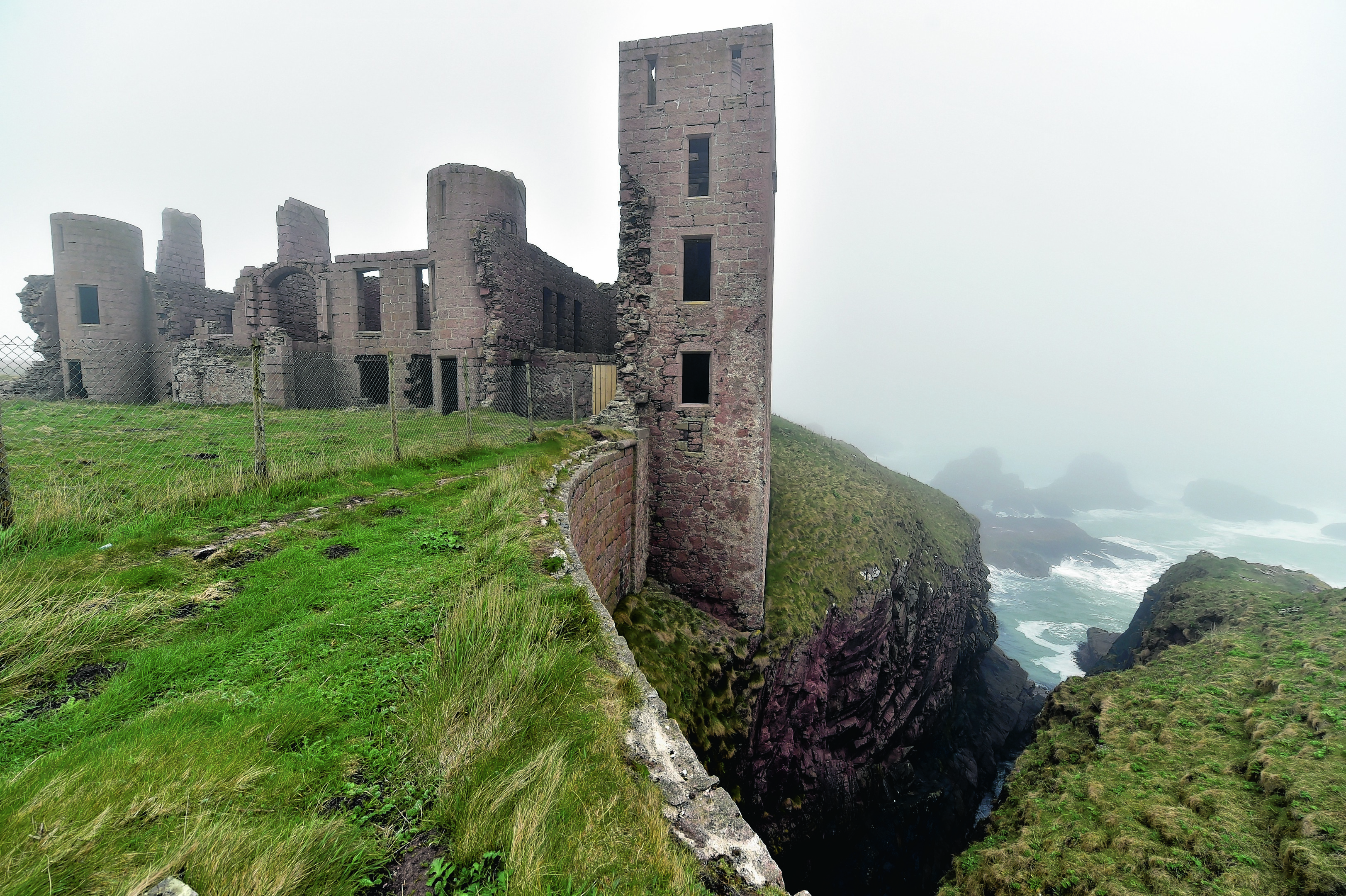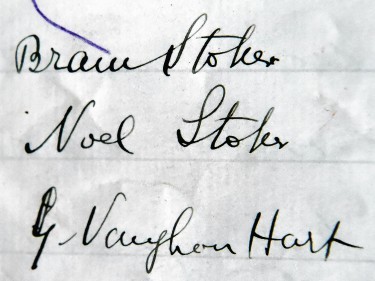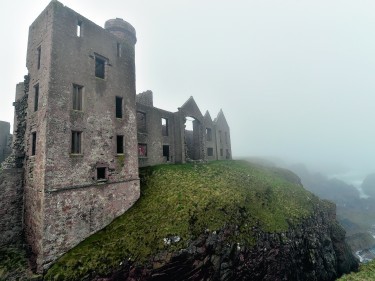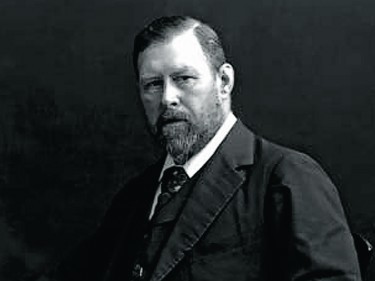“Second visit to Port Errol. Delighted with everything and everybody. Hope to come again soon to The Kilmarnock Arms.”
This short but glowing report, scrawled in flowing black ink within the yellowing pages of a century-old guest book, is the most vital link in an equally-long debate.
The entry, signed “2 to 29 August, 1894”, was written by Bram Stoker – the Irish novelist behind the most famous piece of horror literature written, Dracula.
“It’s of such value to the hotel that we can’t put it on display,” said the Kilmarnock Arms’ current owner, Lucy Taylor, holding the delicate guestbook in her hands.
For the people of Cruden Bay (as Port Errol was renamed in 1924) the entry is cast-iron proof of Stoker’s presence in – and fondness for – the area. Further, it proudly sticks its tongue out to Whitby, the Yorkshire coastal town where much of Dracula is set. Stoker’s signature in the Kilmarnock Arms guest book indicates that the north-east coastal village must have at least partly inspired his gothic horror story.
At the time of Stoker’s visit, Lucy explained, the hotel was a lot less luxurious, with the 22 bedrooms sharing just two bathrooms between them. Today, with its 14 bedrooms – now, of course, all en suite – it’s a lot more comfortable. But even so, you can understand why Stoker, his wife and son, made frequent trips to Cruden Bay.
For a pioneering writer of the horror genre, it must have provided just what he needed – dramatic clifftops and a stark exposure to the tumultuous North Sea. Plus, of course, a certain castle which juts out of the very top of a jagged cliff face on the edge of the bay – New Slains Castle.
“Whitby claims that it was all there, but we claim – literally, we the hotel – that it was here,” said Lucy, commenting about where the inspiration for Castle Dracula derived.
“And when you see Slains and see that it’s right on the edge of the cliffs, and then read the description about Dracula coming out and up the rocks, Whitby just doesn’t have that. So I think we win.”
But with Whitby cleaning up quite nicely in the tourism stakes, is Cruden Bay really winning?
A MISSED OPPORTUNITY
Liz Oakes has run the Cruden Bay Gift Shop at the village’s Bridge Street for seven years. A treasure trove of arts and crafts – many created by locals – the shop is a tourist’s dream.
Any Dracula enthusiast travelling to the area will be pleased by what they find – from the Aberdeenshire-distilled Dracula’s Dram whisky, to stunning paintings of the castle. And at only 10 minutes walk from New Slains, and situated directly across the road from the Kilmarnock Arms, the gift shop could easily feature in any Stoker-fan’s tour.
The problem is, not enough is being done to promote Cruden Bay’s local businesses, Liz firmly believes – let alone the link between the location and Bram Stoker’s novel.
“Over the years, we’ve tried really hard to get signage up, but as you drive to Peterhead on the main road there’s nothing saying there’s something historic here,” said Liz, 60, who has lived locally for 35 years.
“It doesn’t indicate that there’s anything here. But I think there are a lot of things here that need a showcase.”
Running the shop is a labour of love for Liz, rather than as a means to a core income – she works as a classroom assistant at Peterhead Academy to make up the rest of her earnings. However, if more was made of the Dracula connection as it is in Whitby, she believes, the potential for local businesses to flourish could rise significantly.
“When you go to Whitby, the link is very commercialised. But there’s nothing here to support commercial businesses,” she said, shaking her head.
The castle’s private ownership also complicates matters. Any posters or signs erected by locals to promote their businesses are swiftly taken down.
It’s understandable why local enterprises feel somewhat on a limb.
“I would willingly work with anybody that comes along. I have no idea why people don’t want to promote it more. It’s a missed opportunity,” Liz said.
“I get a lot of people coming in to see the castle, and then I mention the Bram Stoker connection. Up until that time, they have had no idea – they only come to see it because they can see it from the roadside. So they are always interested and want to know more. This is why I can’t understand why we can’t promote it.”
A THICK MIST ROLLED IN
The pathway to New Slains Castle couldn’t have been more evocative of Stoker’s supernatural tale as I walked along it. Despite it being a perfectly sunny day four miles inland from the coastline, a thick mist had rolled in at the castle, obscuring the surrounding land in an eerie smoke.
A flock of sea birds screeched intermittently above the castle’s 16th century tower, the dramatic protrusion almost precariously overlooking the crashing waves 80ft below.
Mere feet from the precipice, a collection of tributes to Cameron Smithie act as a sombre warning to coastal walkers of the danger posed by the steep drop. The 15-year-old died on June 1 last year after falling down the cliff.
In the years Bram Stoker would have visited the site, the castle looked very different. Sixty years beforehand, in 1836, it was redesigned as a handsome Scots Baronial Mansion. An enduring theory states that the Irish author may at one point have been a guest of the castle at the request of then owner, the Earl of Errol.
The 300 year occupancy of the castle would end less than 20 years later when it was sold on. Its roof was then removed in 1925 to avoid tax fees, and in the years since the building has slid slowly into disrepair – though its outer and inner walls still stand to their full height. Now a shell of its former grandeur, New Slains Castle appears as if it has been claimed by the very land it perches on, gripped in nature’s mossy hand.
Today, a high fence surrounds the property, originally put in place in 2007 when plans were mooted by its current owners – the Slains Partnership – for it to be converted into holiday homes. The conversion hasn’t come to pass, but the fence remains.
A call into the property owner’s agent revealed the historical site hasn’t been forgotten. Claire Leven, of CML Property, said that new ideas for the site are being formulated, but are not yet ready to be announced.
In the meantime, visitors to the area can only admire the ruins from a short distance.
THE LOCATION AND THE STORY
For Aberdeenshire Council’s Head of Economic Development, Belinda Miller, the property’s private ownership need not be a deterrent for tourism to the Buchan coast landmark.
“Despite the building being privately-owned, the history of New Slains Castle and the historical link to Bram Stoker is part of the heritage of the local area and is still well publicised by local people,” she explained.
“Those who do actually visit the castle tend to get there on foot using well-establish footpaths and tracks, having normally parked at the small car park, in line with normal countryside access issues.
“While the links could be further promoted by the land owner, it is the location and the story that are the main interest.”
Contrary to Liz Oakes’s position, Belinda believes that some considerable effort has been put behind promoting the link between Cruden Bay and Dracula.
“Wherever New Slains Castle or Cruden Bay is mentioned in tourist publications about the area, the link with Bram Stoker and inspiration for his classic Dracula story usually features,” she said, drawing on the examples of the What to See & Do guide, Scotland’s Castle Trail guide and the Discover East Grampian Coast 2014 guide.
“A locally-produced tourism leaflet about Cruden Bay from a few years ago also majored on the link to Bram Stoker and the history of New Slains Castle,” she added.
The area and its historical and cultural links, she said, are also key elements in promoting the Energetica corridor initiative – a 25 year vision to create an exemplar low carbon, sustainable development corridor that is hoped to attract energy organisations and individuals to a natural and built coastal environment.
Hearing all this information, it certainly seems like a sincere marketing effort is being put behind this stretch of stunning north-east coastline on a whole. But what of Cruden Bay itself? Are there plans to put in road signage such as Liz Oakes dearly wants?
The Aberdeenshire Council team explained that, as the site is private property, any such call for signage would need to come from the owners themselves. Perhaps once ideas for the site are announced, the missing link in the Dracula connection could be put in place?
A JAGGED LINE AGAINST THE MOONLIT SKY
Back at the Kilmarnock Arms, where my brush with Bat began, I leafed through my personal hardback edition of Stoker’s novel.
One hundred and seventeen years after the original was first published, its descriptions remain remarkably evocative of the castle which stands only minutes away from the hotel.
Having made my own journey to the north-east’s version of Castle Dracula, I could imagine Stoker’s excitement at penning his protagonist Jonathan Harker’s reaction to seeing its literary counterpart for the first time: “…a vast ruined castle, from whose tall black windows came no ray of light, and whose broken battlements showed a jagged line against the moonlit sky”.
I could see there and then how Cruden Bay may well be sitting on a somewhat-dormant goldmine of tourist trade.
Between 20 to 30 people stay at the hotel each year specifically to see it and New Slains, Lucy Taylor told me, rousing me from my daydream. To capitalise on this, she and her husband, Martin, are currently working with local woman, Jill McWilliams, to set up a display in the hotel’s bar by the end of the summer depicting the area’s connection to the horror novelist and his creation.
Not all the Stoker fans who visit the are devout vampire enthusiasts, Lucy explained, though some definitely are. And those dedicated individuals clearly consider Cruden Bay a major site of interest on their pilgrimage.
“One guy dressed as Dracula came to see the book,” Lucy said with a suppressed giggle.
“He was completely polite and made no reference to what he was wearing. He just asked if this is where Bram Stoker stayed, and then calmly went on his way.”
Cruden Bay will host two celebratory events in August. The Port Erroll Harbour Fish Festival and Tryggve Gran commemoration – marking the centenary of the first manned flight across the North Sea – will be held on Saturday, August 23.




